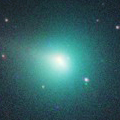
|
Now it is bright as 9.2 mag (Feb. 5, Osamu Miyazaki). It stays bright as 9-10 mag until March. In the Northern Hemisphere, it stays observable in excellent condition for a long time. In the Southern Hemisphere, it stays extremely low after this.
Date(TT) R.A. (2000) Decl. Delta r Elong. m1 Best Time(A, h)
Feb. 5 1 35.67 7 4.4 1.283 1.307 68 8.9 18:58 ( 58, 47)
Feb. 12 1 53.55 11 53.6 1.318 1.312 67 9.0 19:04 ( 68, 48)
|
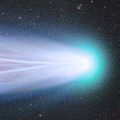
|
It brightened up to 3 mag from mid December to late December. Now it is fading. It faded down to 8.5 mag in late January (Jan. 28, Chris Wyatt). In the Southern Hemisphere, it becomes unobservable temporarily in early February. But it will appear in the morning sky in mid February. In the Northern Hemisphere, it will become observable again at 13 mag in late April.
Date(TT) R.A. (2000) Decl. Delta r Elong. m1 Best Time(A, h)
Feb. 5 21 32.65 -35 47.1 1.783 0.922 20 9.4 18:58 ( 62,-24)
Feb. 12 21 29.70 -35 28.3 1.876 1.027 21 10.0 5:24 (296,-26)
|
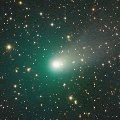
|
Now it is 9.9 mag (Feb. 5, Osamu Miyazaki). It stays bright as 10 mag until spring for a long time. It stays observable in good condition for a long time. It locates somewhat low in the Southern Hemisphere,
Date(TT) R.A. (2000) Decl. Delta r Elong. m1 Best Time(A, h)
Feb. 5 6 41.72 25 56.9 2.722 3.563 143 10.0 21:40 ( 0, 81)
Feb. 12 6 38.20 24 33.0 2.794 3.568 135 10.0 21:09 ( 0, 79)
|
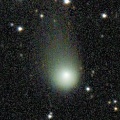
|
Now it is bright as 11.7 mag (Jan. 27, Osamu Miyazaki). It is expected to be observable at 5-6 mag for a long time from 2022 to 2023. In the Northern Hemisphere, it stays observable in good condition until autumn. However, it is not observable at the high light from autumn to 2023 summer. In the Southern Hemisphere, it will be observable after February. Then it will be observable in good condition at the high light.
Date(TT) R.A. (2000) Decl. Delta r Elong. m1 Best Time(A, h)
Feb. 5 18 25.18 11 35.2 4.645 4.081 49 10.4 5:29 (278, 32)
Feb. 12 18 30.24 11 26.6 4.523 4.018 53 10.3 5:24 (281, 35)
|
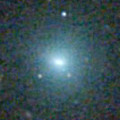
|
Brightened very rapidly. Now it is very bright as 10.2 mag (Feb. 3, Osamu Miyazaki). It is observable at 10 mag in good condition until February.
Date(TT) R.A. (2000) Decl. Delta r Elong. m1 Best Time(A, h)
Feb. 5 2 42.53 5 42.2 0.644 1.122 84 10.5 18:58 ( 35, 56)
Feb. 12 3 18.64 8 2.2 0.658 1.153 86 10.9 19:04 ( 36, 59)
|
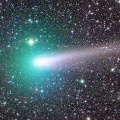
|
Now it is very bright as 10.0 mag (Feb. 2, Osamu Miyazaki). It stays observable in good condition for a long time. It locates somewhat low in the Southern Hemisphere,
Date(TT) R.A. (2000) Decl. Delta r Elong. m1 Best Time(A, h)
Feb. 5 8 28.04 28 41.4 0.692 1.661 163 10.7 23:26 ( 0, 84)
Feb. 12 8 24.48 28 13.5 0.761 1.714 157 11.1 22:55 ( 0, 83)
|
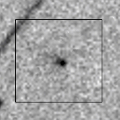
|
In the Northern Hemisphere, it stays extremely low until spring. In the Southern Hemisphere, it stays observable at 11 mag until June.
Date(TT) R.A. (2000) Decl. Delta r Elong. m1 Best Time(A, h)
Feb. 5 18 41.65 -20 50.9 2.294 1.608 36 11.4 5:29 (303, 8)
Feb. 12 19 4.54 -20 31.4 2.250 1.591 37 11.3 5:24 (302, 8)
|
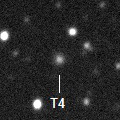
|
Now it is 12.7 mag (Jan. 31, Chris Wyatt). It will brighten up to 11.5 mag in spring. It stas observable in good condition for a long time.
Date(TT) R.A. (2000) Decl. Delta r Elong. m1 Best Time(A, h)
Feb. 5 12 8.09 -29 13.1 3.814 4.366 118 11.9 3:09 ( 0, 26)
Feb. 12 12 7.43 -28 46.7 3.716 4.353 124 11.8 2:41 ( 0, 26)
|
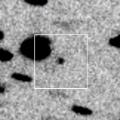
|
Now it is 14.7 mag (Feb. 3, Giuseppe Pappa). It will brighten up to 12 mag from winter to spring.
Date(TT) R.A. (2000) Decl. Delta r Elong. m1 Best Time(A, h)
Feb. 5 17 24.18 -20 32.4 1.924 1.569 54 12.3 5:29 (316, 21)
Feb. 12 17 46.61 -21 20.4 1.876 1.558 56 12.3 5:24 (317, 20)
|
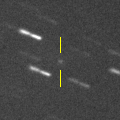
|
Now it is bright as 12.8 mag (Jan. 30, Charles S. Morris). Cometary activity was detected. It stays 13 mag until spring. In the Northern Hemisphere, it is observable only until early March. In the Southern Hemisphere, it is not observable until late May. But it will be observable in good condition after that.
Date(TT) R.A. (2000) Decl. Delta r Elong. m1 Best Time(A, h)
Feb. 5 19 20.53 48 13.0 1.432 1.418 69 13.3 5:29 (232, 36)
Feb. 12 20 21.47 48 58.5 1.411 1.342 65 13.0 5:24 (229, 30)
|
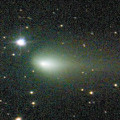
|
It brightened up to 10.6 mag in autumn (Oct. 10, Osamu Miyazaki). Now it is fading. It has already faded down to 13.0 mag (Jan. 31, Chris Wyatt). It stays observable in good condition for a long time.
Date(TT) R.A. (2000) Decl. Delta r Elong. m1 Best Time(A, h)
Feb. 5 6 20.32 10 29.3 1.342 2.175 137 13.2 21:19 ( 0, 66)
Feb. 12 6 21.75 11 11.5 1.437 2.217 131 13.5 20:53 ( 0, 66)
|

|
Now it is bright as 11.1 mag (Jan. 24, Charles S. Morris). It has a large diffuse coma.
Date(TT) R.A. (2000) Decl. Delta r Elong. m1 Best Time(A, h)
Feb. 5 4 15.64 29 48.8 5.527 5.955 111 13.5 19:14 ( 0, 85)
Feb. 12 4 16.30 29 37.8 5.636 5.957 104 13.6 19:04 ( 34, 84)
|

|
Now it is 15.8 mag (Jan. 18, J. Drummond). It will brighten up to 13 mag in spring. In the Southern Hemisphere, it stays observable in good condition for a long time. In the Northern Hemisphere, it is not observable until autumn.
Date(TT) R.A. (2000) Decl. Delta r Elong. m1 Best Time(A, h)
Feb. 5 11 45.64 -65 58.6 3.183 3.384 93 13.8 2:48 ( 0,-11)
Feb. 12 11 16.57 -68 5.8 3.105 3.359 96 13.7 1:51 ( 0,-13)
|
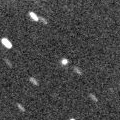
|
Now it is 15.5 mag (Jan. 22, Ken-ichi Kadota). It is expected to brighten very rapidly up to 4.5 mag in April. However, it is not observable at the high light. In the Northern Hemisphere, it stays observable until early February when it brightens up to 14 mag. Then it will appear at 6 mag in mid May, and it stays observable in good condition after that while the comet will be fading. In the Southern Hemisphere, it is not observable until August.
Date(TT) R.A. (2000) Decl. Delta r Elong. m1 Best Time(A, h)
Feb. 5 22 56.93 0 33.3 2.491 1.717 30 14.3 18:58 ( 82, 12)
Feb. 12 23 8.11 0 16.4 2.427 1.596 25 14.0 19:04 ( 85, 8)
|
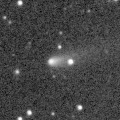
|
Now it is 14.2 mag (Jan. 31, Toshihiko Ikemura, Hirohisa Sato). It is observable at 13.5 mag in good condition until spring.
Date(TT) R.A. (2000) Decl. Delta r Elong. m1 Best Time(A, h)
Feb. 5 9 56.07 18 4.3 1.486 2.462 169 14.1 0:58 ( 0, 73)
Feb. 12 9 50.51 18 29.8 1.458 2.442 174 14.0 0:25 ( 0, 73)
|

|
It brightened up to 12.3 mag from spring to summer (June 15, Marco Goiato). Now it is fading. It has already faded down to 14.2 mag (Jan. 15, Ken-ichi Kadota).
Date(TT) R.A. (2000) Decl. Delta r Elong. m1 Best Time(A, h)
Feb. 5 14 21.65 11 25.0 3.928 4.295 105 14.0 5:22 ( 0, 66)
Feb. 12 14 17.50 13 13.3 3.851 4.334 113 14.0 4:51 ( 0, 68)
|
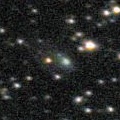
|
Now it is 14.9 mag (Nov. 28, Thomas Lehmann). It is expected to brighten up to 11 mag from spring to summer. In the Southen Hemisphere, it is not observable until February, but it stays observable in good condition for a long time after that. In the Northern Hemisphere, it is hardly observable after this.
Date(TT) R.A. (2000) Decl. Delta r Elong. m1 Best Time(A, h)
Feb. 5 19 49.56 -13 1.9 3.284 2.386 20 14.4 5:29 (286, 0)
Feb. 12 19 56.67 -14 13.9 3.184 2.331 25 14.2 5:24 (289, 3)
|
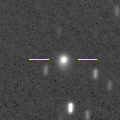
|
Now it is 14.5 mag (Jan. 31, Thomas Lehmann). It is expected to brighten up to 10 mag in 2023. In the Northern Hemisphere, it stays observable in good condition until 2023 autumn. In the Southern Hemipshere, it locates extremely low from January to February. Then it stays unobservable until 2023 summer.
Date(TT) R.A. (2000) Decl. Delta r Elong. m1 Best Time(A, h)
Feb. 5 12 56.84 49 40.8 4.597 5.214 124 14.5 3:58 (180, 75)
Feb. 12 12 50.98 51 32.1 4.508 5.157 126 14.4 3:25 (180, 74)
|
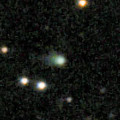
|
Now it is 15.0 mag (Jan. 14, Ken-ichi Kadota). It is expected to brighten up to 11 mag in 2023. In the Northern Hemisphere, it stays observable in good condition for a long time. It is not observable in the Southern Hemisphere.
Date(TT) R.A. (2000) Decl. Delta r Elong. m1 Best Time(A, h)
Feb. 5 16 42.92 33 12.4 5.201 5.141 81 14.7 5:29 (264, 62)
Feb. 12 16 42.66 33 58.0 5.083 5.101 85 14.6 5:24 (265, 67)
|

|
Now it is 15.8 mag (Oct. 4, Thomas Lehmann). Appearing in the morning. It will brighten up to 13 mag in summer.
Date(TT) R.A. (2000) Decl. Delta r Elong. m1 Best Time(A, h)
Feb. 5 17 36.43 -24 50.5 3.654 3.132 51 14.7 5:29 (317, 15)
Feb. 12 17 46.72 -25 7.6 3.567 3.124 55 14.7 5:24 (319, 17)
|

|
Now it is 15.9 mag (Jan. 2, Thomas Lehmann). It will brighten up to 12.5 mag in summer. In the Southern Hemisphere, it stays observable in excellent condition for a long time, although it becomes low temporarily in February. In the Northern Hemisphere, it is not observable until August.
Date(TT) R.A. (2000) Decl. Delta r Elong. m1 Best Time(A, h)
Feb. 5 22 24.97 -58 33.9 4.315 3.678 44 14.8 18:58 ( 35,-26)
Feb. 12 22 27.81 -57 34.7 4.275 3.639 44 14.8 19:04 ( 38,-30)
|
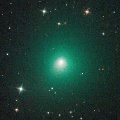
|
It brightened up to 9.5 mag in early summer (June 27, Marco Goiato). Now it is fading. It has faded down to 12.7 mag in autumn (Nov. 22, Thomas Lehmann). Now it is not observable. In the Southern Hemisphere, it will appear in the morning sky at 15 mag in late February. In the Northern Hemisphere, it is not observable until June when the comet will fade down to 17 mag.
Date(TT) R.A. (2000) Decl. Delta r Elong. m1 Best Time(A, h)
Feb. 5 20 48.49 -32 34.1 4.076 3.149 17 14.8 5:29 (295,-22)
Feb. 12 21 1.12 -32 18.9 4.111 3.205 20 15.0 5:24 (296,-20)
|
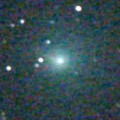
|
It brightened up to 9.8 mag from autumn to winter (Nov. 22, Thomas Lehmann). Now it is fading. It has already faded down to 14.4 mag (Jan. 24, Charles S. Morris). It will be fainter than 18 mag in March.
Date(TT) R.A. (2000) Decl. Delta r Elong. m1 Best Time(A, h)
Feb. 5 1 15.11 -9 56.2 2.349 2.027 59 14.9 18:58 ( 49, 31)
Feb. 12 1 29.40 -8 10.9 2.457 2.076 56 15.5 19:04 ( 54, 29)
|
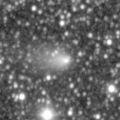
|
It brightened up to 11.5 mag in outburst in October (Oct. 22, Marco Goiato). Now it is fading. It has already faded down to 15.1 mag (Jan. 24, A. Diepvens). But Hiroshi Abe reported it is bright as 12.3 mag on Jan. 22. In the Southern Hemisphere, it is already unobservable. In the Northern Hemisphere, it stays observable until early February.
Date(TT) R.A. (2000) Decl. Delta r Elong. m1 Best Time(A, h)
Feb. 5 23 0.52 -5 55.3 2.803 1.989 28 15.2 18:58 ( 76, 9)
Feb. 12 23 16.32 -4 22.4 2.868 2.020 25 15.5 19:04 ( 80, 7)
|

|
Now it is 15.9 mag (Oct. 8, Thomas Lehmann). It stays at 14-15 mag for a long time from 2021 to 2022. In the Southern Hemisphere, it stays observable in excellent condition for a long time. In the Northern Hemiphere, it locates extremely low in spring.
Date(TT) R.A. (2000) Decl. Delta r Elong. m1 Best Time(A, h)
Feb. 5 17 17.48 -33 34.1 5.537 5.045 55 15.2 5:29 (325, 11)
Feb. 12 17 19.28 -34 33.5 5.439 5.053 62 15.2 5:24 (329, 12)
|
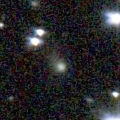
|
Now it is 15.6 mag (Jan. 31, Thomas Lehmann). It is expected to brighten up to 11 mag in 2023. In the Northern Hemisphere, it stays observable in good condition until November. But it becomes unobservable after that. In the Southern Hemisphere, it is not observable until February. But it will be observable in good condition at the high light.
Date(TT) R.A. (2000) Decl. Delta r Elong. m1 Best Time(A, h)
Feb. 5 18 39.99 17 22.4 5.804 5.232 50 15.4 5:29 (270, 32)
Feb. 12 18 44.14 17 18.8 5.707 5.184 53 15.4 5:24 (273, 36)
|
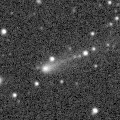
|
It brightened rapidly. Now it is 15.1 mag (Jan. 31, Toshihiko Ikemura, Hirohisa Sato). It stays 15 mag until February, and it is observable in excellent condition.
Date(TT) R.A. (2000) Decl. Delta r Elong. m1 Best Time(A, h)
Feb. 5 8 3.48 14 13.3 1.587 2.546 163 15.4 23:01 ( 0, 69)
Feb. 12 7 58.63 14 0.5 1.628 2.558 155 15.5 22:29 ( 0, 69)
|
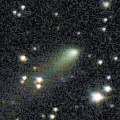
|
Now it is 15.6 mag (Jan. 7, Toshihiko Ikemura, Hirohisa Sato). It will be fading after this. In the Northern Hemisphere, it stays observable in good condition for a long time. It locates low in the Southern Hemisphere.
Date(TT) R.A. (2000) Decl. Delta r Elong. m1 Best Time(A, h)
Feb. 5 15 58.51 28 4.8 2.556 2.707 87 15.4 5:29 (284, 70)
Feb. 12 15 50.63 30 25.3 2.479 2.746 94 15.5 5:24 (286, 77)
|
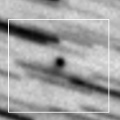
|
Now it is 15.3 mag (Jan. 9, D. Buczynski). It is expected to brighten up to 11 mag in summer. In the Northern Hemisphere, it stays observable in good condition until June when it brightens up to 11 mag. But it is not observable after the high light. In the Souther Hemisphere, it is not observable until October.
Date(TT) R.A. (2000) Decl. Delta r Elong. m1 Best Time(A, h)
Feb. 5 23 17.04 50 55.5 2.898 2.763 72 15.7 18:58 (131, 38)
Feb. 12 23 28.13 51 7.2 2.872 2.683 69 15.6 19:04 (132, 35)
|
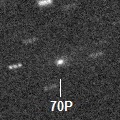
|
Now it is 15.8 mag (Jan. 27, Toshihiko Ikemura, Hirohisa Sato). It stays 15.5 mag until March, and it is observable in excellent condition.
Date(TT) R.A. (2000) Decl. Delta r Elong. m1 Best Time(A, h)
Feb. 5 11 54.21 8 10.3 1.297 2.147 139 15.7 2:55 ( 0, 63)
Feb. 12 11 53.20 8 55.7 1.270 2.167 147 15.7 2:27 ( 0, 64)
|
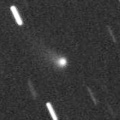
|
Now it is 15.0 mag (Feb. 1, Thomas Lehmann). It stays observable at 15-16 mag for a long time.
Date(TT) R.A. (2000) Decl. Delta r Elong. m1 Best Time(A, h)
Feb. 5 12 46.23 11 56.8 2.732 3.432 128 15.7 3:47 ( 0, 67)
Feb. 12 12 36.06 11 33.7 2.674 3.465 137 15.7 3:10 ( 0, 66)
|
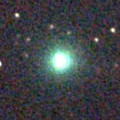
|
It brightened very rapidly, and brightened up to 8.9 mag (Sept. 11, Chris Wyatt). Now it is fading. It has already faded down to 15.7 mag (Dec. 7, E. Cortes, N. Paul, B. Lutkenhoner). In the Southern Hemisphere, it stays observable after this while the comet will be fading. It is not observable after this in the Northern Hemisphere.
Date(TT) R.A. (2000) Decl. Delta r Elong. m1 Best Time(A, h)
Feb. 5 17 17.22 -54 47.0 2.730 2.382 59 15.7 5:29 (337, -7)
Feb. 12 17 28.64 -54 59.6 2.729 2.451 63 16.0 5:24 (338, -6)
|
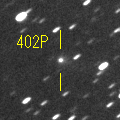
|
First return of a new periodic comet observed at 16 mag from 2003 to 2004. Now it is 16.1 mag (Jan. 3, Toshihiko Ikemura, Hirohisa Sato). It stays 16 mag until March, and it stays observable in excellent condition.
Date(TT) R.A. (2000) Decl. Delta r Elong. m1 Best Time(A, h)
Feb. 5 6 1.79 7 47.6 3.215 3.949 132 16.0 21:00 ( 0, 63)
Feb. 12 6 0.65 8 46.0 3.293 3.953 125 16.0 20:31 ( 0, 64)
|
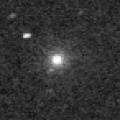
|
It was observed at 9-10 mag from late July to early August. Although it had been unobservable for a long time, it is appearing in the morning sky now.
Date(TT) R.A. (2000) Decl. Delta r Elong. m1 Best Time(A, h)
Feb. 5 16 30.15 -26 37.0 3.117 2.862 65 16.0 5:29 (331, 22)
Feb. 12 16 34.88 -27 23.6 3.100 2.947 71 16.2 5:24 (335, 23)
|
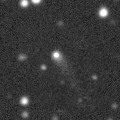
|
Now it is 16.0 mag (Jan. 15, Ken-ichi Kadota). It stays observable at 16 mag from 2021 to 2022. Appearing in the morning sky also in the Southern Hemisphere.
Date(TT) R.A. (2000) Decl. Delta r Elong. m1 Best Time(A, h)
Feb. 5 16 7.90 16 15.1 4.847 4.809 81 16.2 5:29 (304, 61)
Feb. 12 16 11.55 17 49.1 4.767 4.821 87 16.1 5:24 (309, 65)
|
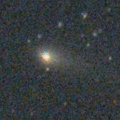
|
It brightened up to 13.1 mag in autumn (Oct. 28, Toshihiko Ikemura, Hirohisa Sato). Now it is fading. But it is still bright as 14.2 mag (Jan. 26, Giuseppe Pappa). It stays observable in good condition for a long time. But it will be fainter than 18 mag in March.
Date(TT) R.A. (2000) Decl. Delta r Elong. m1 Best Time(A, h)
Feb. 5 2 46.88 9 48.8 1.662 1.880 86 16.2 18:58 ( 37, 60)
Feb. 12 3 1.48 11 5.4 1.755 1.910 83 16.4 19:04 ( 46, 59)
|

|
Now it is 16.2 mag (Jan. 27, SONEAR Observatory, Oliveira). It will be fading slowly after this. In the Southern Hemisphere, it stays observable in good condition for a long time. In the Northern Hemisphere, it is not observable until July.
Date(TT) R.A. (2000) Decl. Delta r Elong. m1 Best Time(A, h)
Feb. 5 23 56.27 -45 0.2 4.775 4.133 44 16.2 18:58 ( 39, -7)
Feb. 12 0 5.05 -43 17.0 4.836 4.164 42 16.3 19:04 ( 43, -9)
|

|
Brightened rapidly. Now it is 16.5 mag (Jan. 24, Charles S. Morris). It is observable at 15.5-16 mag in good condition in winter.
Date(TT) R.A. (2000) Decl. Delta r Elong. m1 Best Time(A, h)
Feb. 5 2 23.41 11 43.1 3.847 3.829 81 16.4 18:58 ( 49, 58)
Feb. 12 2 28.96 11 59.5 3.954 3.834 75 16.5 19:04 ( 58, 54)
|
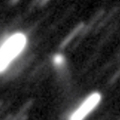
|
It was observed at 15 mag in 2021. Now it is fading. It stays observable at 17 mag for a while in 2022.
Date(TT) R.A. (2000) Decl. Delta r Elong. m1 Best Time(A, h)
Feb. 5 18 20.36 2 12.5 5.648 5.020 46 16.6 5:29 (288, 27)
Feb. 12 18 25.06 3 19.8 5.588 5.034 51 16.6 5:24 (290, 31)
|

|
Now it is 17.2 mag (Jan. 18, J. Drummond). It brightened rapidly. It stays 17 mag for a long time from 2021 to 2022. In the Southern Hemisphere, it stays observable in good condition for a long time. In the Northern Hemisphere, it will be observable only in extremely low sky from autumn to winter.
Date(TT) R.A. (2000) Decl. Delta r Elong. m1 Best Time(A, h)
Feb. 5 7 38.08 -47 13.3 4.902 5.368 113 16.7 22:35 ( 0, 8)
Feb. 12 7 28.07 -47 14.1 4.925 5.374 112 16.7 21:57 ( 0, 8)
|
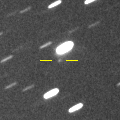
|
Now it is 16.5 mag (Jan. 29, Toshihiko Ikemura, Hirohisa Sato). It is observable at 16.5 mag in good condition from winter to spring.
Date(TT) R.A. (2000) Decl. Delta r Elong. m1 Best Time(A, h)
Feb. 5 10 21.28 -25 36.6 1.562 2.365 135 16.8 1:23 ( 0, 29)
Feb. 12 10 20.66 -23 54.0 1.520 2.370 141 16.7 0:54 ( 0, 31)
|
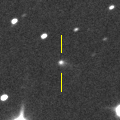
|
Now it is 16.9 mag (Jan. 31, Toshihiko Ikemura, Hirohisa Sato). It will brighten up to 14 mag in early 2023. It stays observable in good condition until spring.
Date(TT) R.A. (2000) Decl. Delta r Elong. m1 Best Time(A, h)
Feb. 5 4 18.20 5 41.2 4.362 4.747 107 16.8 19:17 ( 0, 61)
Feb. 12 4 19.00 6 18.4 4.421 4.705 100 16.8 19:04 ( 7, 61)
|
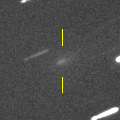
|
First return of a new periodic comet which brightened up to 17 mag in 2011. Now it is 18.2 mag (Jan. 8, Toshihiko Ikemura, Hirohisa Sato). It brightened up to 16.8 mag in October (Oct. 10, Ken-ichi Kadota), however, it has been fading after that.
Date(TT) R.A. (2000) Decl. Delta r Elong. m1 Best Time(A, h)
Feb. 5 14 50.06 -11 57.9 1.318 1.675 92 16.8 5:29 (353, 43)
Feb. 12 15 1.29 -12 52.4 1.280 1.700 96 16.8 5:24 (357, 42)
|
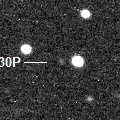
|
Now it is 18.7 mag (Jan. 1, W. Hasubick). It was expected to brighten up to 16.5-17 mag in winter. In its last apparition in 2015, it brightened up to 13 mag. But actually, it is fainter than this ephemeris recently.
Date(TT) R.A. (2000) Decl. Delta r Elong. m1 Best Time(A, h)
Feb. 5 0 41.78 -8 11.0 2.046 1.626 51 16.9 18:58 ( 57, 27)
Feb. 12 0 58.78 -5 46.3 2.069 1.609 49 16.8 19:04 ( 62, 26)
|

|
Now it is 16.9 mag (Jan. 8, Toshihiko Ikemura, Hirohisa Sato). Fading slowly. In the Northern Hemisphere, it stays observable in good condition for a long time. In the Southern Hemisphere, it is not observable after this.
Date(TT) R.A. (2000) Decl. Delta r Elong. m1 Best Time(A, h)
Feb. 5 19 7.42 50 24.1 9.285 9.029 72 16.9 5:29 (230, 39)
Feb. 12 19 10.79 51 9.1 9.280 9.037 72 16.9 5:24 (229, 42)
|
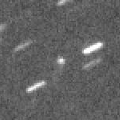
|
Now it is 16.5 mag (Jan. 9, ATLAS-HKO, Haleakala). It started fading before the perihelion passage. It was predicted to stay at 16 mag for a long time, but actually, it will be fainter than 18 mag in autumn. In the Northern Hemisphere, it stays observable in good condition for a long time. In the Southern Hemisphere, it is not observable until 2023.
Date(TT) R.A. (2000) Decl. Delta r Elong. m1 Best Time(A, h)
Feb. 5 23 0.31 81 2.2 3.561 3.825 98 16.9 18:58 (169, 37)
Feb. 12 23 10.60 79 29.0 3.614 3.814 94 17.0 19:04 (167, 36)
|
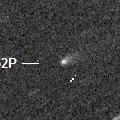
|
It brightened up to 16.4 mag from autumn to winter (Oct. 6, ATLAS-MLO, Mauna Loa). Now it is fading. It has already faded down to 18.0 mag (Jan. 31, Catalina Sky Survey).
Date(TT) R.A. (2000) Decl. Delta r Elong. m1 Best Time(A, h)
Feb. 5 12 55.05 -10 18.5 1.442 2.106 119 17.0 3:56 ( 0, 45)
Feb. 12 12 54.91 -11 11.5 1.406 2.139 125 17.0 3:28 ( 0, 44)
|

|
It has not been observed yet in this apparition. It was expected to be observable at 16 mag in good condition in spring. But actually, it is fainter than 19.2 mag (Jan. 22, John Drummond).
Date(TT) R.A. (2000) Decl. Delta r Elong. m1 Best Time(A, h)
Feb. 5 16 0.03 -34 1.7 1.538 1.542 71 17.3 5:29 (340, 18)
Feb. 12 16 26.42 -34 30.1 1.475 1.516 72 17.1 5:24 (340, 17)
|
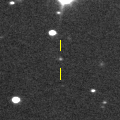
|
Now it is 16.6 mag (Jan. 29, Observatoire Chante-Perdrix, Dauban). It will brighten up to 11.5 mag in 2022 winter. It stays observable while the comet will be brightening slowly.
Date(TT) R.A. (2000) Decl. Delta r Elong. m1 Best Time(A, h)
Feb. 5 3 1.97 13 48.4 2.895 3.078 91 17.1 18:58 ( 35, 65)
Feb. 12 3 5.61 14 12.1 2.961 3.039 85 17.1 19:04 ( 49, 62)
|
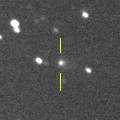
|
Now it is 17.0 mag (Jan. 29, ATLAS-MLO, Mauna Loa). It continued brightening for a while even after the perihelion passage. It stays observable at 16-17 mag in good condition for a while.
Date(TT) R.A. (2000) Decl. Delta r Elong. m1 Best Time(A, h)
Feb. 5 4 22.51 -8 23.5 3.653 4.008 104 17.1 19:21 ( 0, 47)
Feb. 12 4 23.76 -7 13.2 3.761 4.027 98 17.1 19:04 ( 3, 48)
|

|
Now it is 18.0 mag (Jan. 31, Toshihiko Ikemura, Hirohisa Sato). It is expected to brighten up to 11 mag from summer to autumn. It stays observable in good condition in the Southern Hemisphere. In the Northern Hemisphere, it becomes extremely low from August to September.
Date(TT) R.A. (2000) Decl. Delta r Elong. m1 Best Time(A, h)
Feb. 5 10 59.92 25 25.9 1.601 2.521 153 17.3 2:01 ( 0, 80)
Feb. 12 10 53.62 26 44.4 1.519 2.465 158 17.1 1:28 ( 0, 82)
|
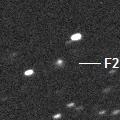
|
Now it is 17.2 mag (Jan. 28, ATLAS-HKO, Haleakala). It stays observable at 17-18 mag for a long time until 2024.
Date(TT) R.A. (2000) Decl. Delta r Elong. m1 Best Time(A, h)
Feb. 5 14 36.47 -4 5.6 8.681 8.866 97 17.1 5:29 (357, 51)
Feb. 12 14 34.80 -3 42.1 8.553 8.862 105 17.1 5:08 ( 0, 51)
|
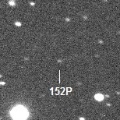
|
It will brighten up to 16 mag from spring to summer. It locates somewhat low in the Northern Hemisphere.
Date(TT) R.A. (2000) Decl. Delta r Elong. m1 Best Time(A, h)
Feb. 5 18 13.24 -21 47.5 3.748 3.097 42 17.3 5:29 (308, 12)
Feb. 12 18 24.00 -21 53.2 3.681 3.099 47 17.2 5:24 (310, 14)
|
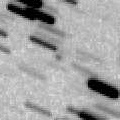
|
Now it is 17.8 mag (Jan. 2, Ken-ichi Kadota). It is expected to brighten up to 13.5 mag from June to July. It is observable only in the Southern Hemisphere at the high light. In the Northern Hemisphere, it is observable only until March when it brightens up to 16.5 mag.
Date(TT) R.A. (2000) Decl. Delta r Elong. m1 Best Time(A, h)
Feb. 5 1 10.67 5 38.6 2.441 2.171 62 17.3 18:58 ( 63, 41)
Feb. 12 1 12.61 4 0.8 2.493 2.096 55 17.2 19:04 ( 68, 34)
|
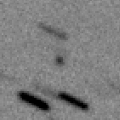
|
Now it is 17.6 mag (Jan. 19, Yasukazu Ikari). It is observable at 17 mag from November to March. It is observable in good condition in the Northern Hemisphere, but it locates low in the Southern Hemisphere.
Date(TT) R.A. (2000) Decl. Delta r Elong. m1 Best Time(A, h)
Feb. 5 5 19.64 30 23.1 1.794 2.495 125 17.2 20:18 ( 0, 85)
Feb. 12 5 21.44 30 51.1 1.860 2.486 118 17.3 19:53 ( 0, 86)
|
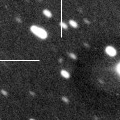
|
Now it is 17.2 mag (Jan. 22, ATLAS-HKO, Haleakala). It will brighten up to 13-14 mag from 2024 to 2025.
Date(TT) R.A. (2000) Decl. Delta r Elong. m1 Best Time(A, h)
Feb. 5 7 17.07 -31 33.7 7.890 8.491 124 17.3 22:15 ( 0, 23)
Feb. 12 7 14.88 -31 16.7 7.878 8.454 122 17.3 21:45 ( 0, 24)
|
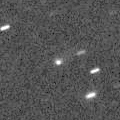
|
Now it is 17.3 mag (Jan. 7, Toshihiko Ikemura, Hirohisa Sato). It will be observable at 17 mag in good condition in spring.
Date(TT) R.A. (2000) Decl. Delta r Elong. m1 Best Time(A, h)
Feb. 5 13 43.15 -9 36.4 4.307 4.713 108 17.3 4:44 ( 0, 45)
Feb. 12 13 43.90 -9 43.1 4.204 4.712 115 17.3 4:17 ( 0, 45)
|
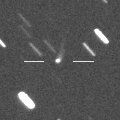
|
Now it is 18.4 mag (Jan. 9, J. Drummond). In the Southern Hemisphere, it stays observable for a long time. In the Northern Hemisphere, it is not observable after this.
Date(TT) R.A. (2000) Decl. Delta r Elong. m1 Best Time(A, h)
Feb. 5 11 3.41 -53 46.5 3.554 3.945 106 17.3 2:05 ( 0, 1)
Feb. 12 10 51.19 -52 51.5 3.524 3.994 111 17.4 1:25 ( 0, 2)
|

|
Now it is 17.8 mag (Jan. 8, Toshihiko Ikemura, Hirohisa Sato). It stays 17-18 mag for a long time from 2021 to 2022. It is observable in excellent condition in the Northern Hemisphere, It locates somewhat low in the Southern Hemisphere.
Date(TT) R.A. (2000) Decl. Delta r Elong. m1 Best Time(A, h)
Feb. 5 2 44.25 28 12.8 5.259 5.374 91 17.4 18:58 ( 72, 73)
Feb. 12 2 41.37 27 47.0 5.387 5.369 83 17.5 19:04 ( 81, 65)
|
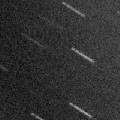
|
It has not been observed yet in this return. It was predicted to brighten up to 16.5 mag in January. It will fade out rapidly after this.
Date(TT) R.A. (2000) Decl. Delta r Elong. m1 Best Time(A, h)
Feb. 5 0 7.94 1 40.6 1.658 1.215 46 17.5 18:58 ( 72, 27)
Feb. 12 0 31.68 5 45.8 1.695 1.245 46 18.0 19:04 ( 77, 28)
|
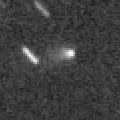
|
Now it is 16.5 mag (Jan. 26, Ken-ichi Kadota). It was expected to brighten up to 15.5 mag in winter. But actually, it is fading even before the perihelion passage. In the Northern Hemisphere, it stays observable in good condition for a long time. It is not observable at all in the Southern Hemisphere.
Date(TT) R.A. (2000) Decl. Delta r Elong. m1 Best Time(A, h)
Feb. 5 16 25.60 85 43.1 2.537 2.946 104 17.5 5:29 (183, 39)
Feb. 12 12 45.88 88 54.1 2.539 2.947 104 17.6 3:36 (180, 36)
|

|
Now it is 17.0 mag (Jan. 26, ATLAS-HKO, Haleakala). In the Northern Hemisphere, it stays observable for a long time while it is getting fainter slowly. In the Southern Hemisphere, it will never be observable again.
Date(TT) R.A. (2000) Decl. Delta r Elong. m1 Best Time(A, h)
Feb. 5 14 53.86 43 34.2 7.390 7.696 104 17.5 5:29 (208, 80)
Feb. 12 14 52.80 44 7.0 7.378 7.743 108 17.6 5:24 (182, 81)
|
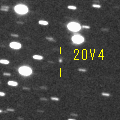
|
Now it is 16.9 mag (Jan. 31, ATLAS-HKO, Haleakala). It is observable at 17.5 mag in good condition in winter.
Date(TT) R.A. (2000) Decl. Delta r Elong. m1 Best Time(A, h)
Feb. 5 7 44.92 3 47.9 4.339 5.249 155 17.6 22:43 ( 0, 59)
Feb. 12 7 42.45 4 6.2 4.384 5.256 149 17.6 22:13 ( 0, 59)
|
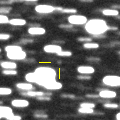
|
Now it is 17.4 mag (Jan. 29, Toshihiko Ikemura, Hirohisa Sato). It will brighten up to 15-16 mag in 2023.
Date(TT) R.A. (2000) Decl. Delta r Elong. m1 Best Time(A, h)
Feb. 5 7 9.84 -23 31.4 4.696 5.386 130 17.6 22:07 ( 0, 31)
Feb. 12 7 1.22 -22 51.5 4.695 5.339 126 17.6 21:31 ( 0, 32)
|
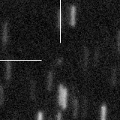
|
Now it is 17.4 mag (Jan. 10, Observatoire Chante-Perdrix, Dauban). It is expected to brighten up to 12 mag from winter to summer in 2023. In the Northern Hemisphere, it stays observable in good condition until 2023 spring. In the Southern Hemisphere, it is not observable until summer.
Date(TT) R.A. (2000) Decl. Delta r Elong. m1 Best Time(A, h)
Feb. 5 1 34.40 48 51.8 5.145 5.184 86 17.7 18:58 (129, 60)
Feb. 12 1 39.09 47 50.4 5.183 5.126 81 17.7 19:04 (125, 56)
|
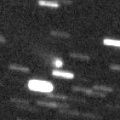
|
It was observed at 16 mag from 2020 to 2021. Now it is fading. It will be fainter than 18 mag in spring.
Date(TT) R.A. (2000) Decl. Delta r Elong. m1 Best Time(A, h)
Feb. 5 15 41.07 -36 45.9 6.030 5.852 74 17.7 5:29 (345, 16)
Feb. 12 15 39.34 -37 30.9 5.941 5.884 81 17.7 5:24 (350, 17)
|
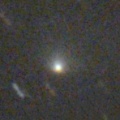
|
It brightened up to 14.5 mag in autumn (Oct. 1, Ken-ichi Kadota). Now it is fading. It has already faded down to 17.1 mag (Jan. 28, Catalina Sky Survey). It will be fading rapidly after this. It will be fainter than 18 mag in February.
Date(TT) R.A. (2000) Decl. Delta r Elong. m1 Best Time(A, h)
Feb. 5 0 59.87 -3 52.2 2.898 2.500 56 17.8 18:58 ( 57, 33)
Feb. 12 1 10.95 -2 36.6 2.987 2.519 52 17.9 19:04 ( 63, 30)
|
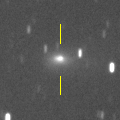
|
It brightened even after the perihelion passage, and it brightened up to 13.5 mag in December (Dec. 6, Katsumi Yoshimoto). Now it is fading. But it is still bright as 16.3 mag (Jan. 24, Charles S. Morris). It is observable in excellent condition in the Northern Hemisphere. It locates low in the Southern Hemisphere.
Date(TT) R.A. (2000) Decl. Delta r Elong. m1 Best Time(A, h)
Feb. 5 6 39.64 40 10.2 1.330 2.173 138 18.0 21:38 (180, 85)
Feb. 12 6 40.10 39 39.9 1.420 2.212 132 18.4 21:11 (180, 85)
|

|
First return of a new periodic comet which brightened up to 16.5 mag in 1997. Now it is 18.5 mag (Jan. 28, Toshihiko Ikemura, Hirohisa Sato). It is fainter than originally predicted, but it is brightening rapidly. It is observable in good condition from January to March.
Date(TT) R.A. (2000) Decl. Delta r Elong. m1 Best Time(A, h)
Feb. 5 8 34.87 26 31.2 1.158 2.129 166 19.6 23:32 ( 0, 81)
Feb. 12 8 30.42 25 35.4 1.158 2.111 159 19.6 23:00 ( 0, 80)
|
|
![]()
 81P/Wild 2
81P/Wild 2 254P/McNaught
254P/McNaught 73P/Schwassmann-Wachmann 3
73P/Schwassmann-Wachmann 3 C/2020 F2 ( ATLAS )
C/2020 F2 ( ATLAS ) 152P/Helin-Lawrence
152P/Helin-Lawrence C/2021 T2 ( Fuls )
C/2021 T2 ( Fuls ) 274P/Tombaugh-Tenagra
274P/Tombaugh-Tenagra C/2021 G2 ( ATLAS )
C/2021 G2 ( ATLAS ) 99P/Kowal 1
99P/Kowal 1 C/2019 T2 ( Lemmon )
C/2019 T2 ( Lemmon ) C/2020 U4 ( PanSTARRS )
C/2020 U4 ( PanSTARRS ) 181P/Shoemaker-Levy 6
181P/Shoemaker-Levy 6 C/2021 D2 ( ZTF )
C/2021 D2 ( ZTF ) C/2018 N2 ( ASASSN )
C/2018 N2 ( ASASSN ) P/2020 V4 ( Rankin )
P/2020 V4 ( Rankin ) A/2021 X1
A/2021 X1 C/2021 Y1 ( ATLAS )
C/2021 Y1 ( ATLAS ) C/2017 Y2 ( PanSTARRS )
C/2017 Y2 ( PanSTARRS ) 284P/McNaught
284P/McNaught 108P/Ciffreo
108P/Ciffreo 440P/2021 W2 ( Kobayashi )
440P/2021 W2 ( Kobayashi )![]()

































































